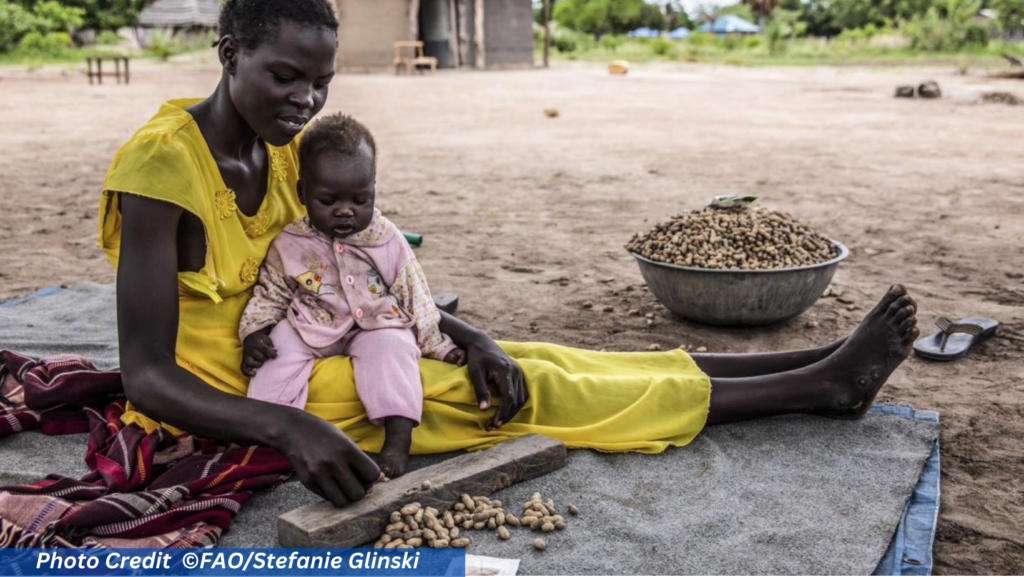Rome/New York, April 27, 2024 – A new study by 16 UN agencies and international organizations said close to 282 million people suffered acute hunger in 2023 in 59 countries, a situation that worsened in recent years with the deadly Covid19 pandemic, wars, climate extremes and economic shocks.
The study, entitled Global Report on Food Crisis 2024 (GRFC), said acute hunger has remained “persistently high” from 2016 to 2023 and it called for action to break the cycle of food crises. The UN, governments and organizations have escalated measures to address acute hunger, but the number of people suffering hunger have remained high beginning of 2024, particularly in Gaza, Afghanistan, and some African nations like Sudan, which cast a worrying shadow over this year.
Read report Global Report on Food Crises 2024 (GRFC).
The Rome-based UN Food and Agriculture Organization (FAO), which is a party to the Global Network Against Food Crisis, said in its website that children and women are at the forefront of these hunger crises, with over 36 million children under 5 years of age acutely malnourished across 32 countries. FAO said acute malnutrition worsened in 2023, particularly among people displaced by conflicts and climate disasters.
The global network urgently “calls for a transformative approach that integrates peace, prevention and development action alongside at-scale emergency efforts to break the cycle of acute hunger which remains at unacceptably high levels.”
“This crisis demands an urgent response,” said UN Secretary-General Antonio Guterres, “Using the data in this report to transform food systems and address the underlying causes of food insecurity and malnutrition will be vital.”
The report is “a roll call of human failings,” and that “in a world of plenty, children are starving to death. The conflicts erupting over the past 12 months compound a dire global situation.” Guterres said in the report’s foreword.
“When we talk about acute food insecurity, we are talking about hunger so severe that it poses an immediate threat to people’s livelihoods and lives. This is hunger that threatens to slide into famine and cause widespread death,” said Dominique Burgeon, Director of the FAO Liaison Office in Geneva.
The UN said the report is the flagship publication of the Food Security Information Network and is based on a collaboration of 16 partners including U.N. agencies like FAO, UNICEF and WFP, and regional and multinational bodies, the European Union, the U.S. Agency for International Development, and technical organizations.
It said the overall percentage of people defined as dangerously food insecure in 2023 was 1.2 per cent lower than in 2022, the problem has worsened significantly since the COVID-19 crisis. When the coronavirus hit in late 2019, around one in six people in 55 countries faced worrying food insecurity levels, compared with one in five just a year later, the report said.
The report said 105 million people in 48 countries suffered acute hunger in 2016 and the number increased to 137.4 million in 53 countries in 2019. The number increased to 155 million in 55 countries in 2020, 192 million in 53 countries in 2021, 257 million in 58 countries 2022 and close to 282 million in 59 countries in 2023.
“Tackling persistent food crises requires urgent long-term national and international investment to transform food systems and boost agricultural and rural development alongside greater crisis preparedness and critical lifesaving assistance at scale, where people need it most. Peace and prevention must also become an integral part of the longer-term food systems transformation. Without this, people will continue to face a lifetime of hunger and the most vulnerable will starve,” the report said.
It said, “Since 2023, needs have outpaced available resources. Humanitarian operations are now desperately overstretched, with many being forced to scale-down and further cut support to the most vulnerable. More equitable and effective global economic governance is imperative and must be matched with government led plans that seek to reduce and end hunger.”
Turning to 2024, the report warned that around 1.1 million people in Gaza, where the Israel-Hamas war is on its seven month, and 79,000 people in South Sudan are facing famine. In addition, South Sudan, Burkina Faso, Somalia and Mali are also facing catastrophic hunger. In Sudan where conflict erupted in April, 2024, the report said 20.3 million people – or 42 per cent of the population – are struggling to find enough to eat daily.
Climate extremes contributed to food shortage. The report pointed out that the El Nino phenomenon, which peaked in early 2024, is a “full impact on food security – including flooding and poor rain in parts of east Africa and drought in southern Africa, especially Malawi, Zambia and Zimbabwe – are like to manifest throughout the year.”
Governments and organizations join force to fight hunger
The Italian government has called for a debate to address the problem and to reinforce collective impact after the publication of the report.
“Looking ahead, the convergence of intensifying conflict and insecurity, the devastating impact of extreme weather events driven mainly by El Niño, and inflation casts a shadow over the outlook for 2024, with crises such as the Sudan and Gaza facing the worst deterioration and the highest severity, requiring immediate action to avert the looming threat of famine,” it said.
Italy said a range of bold and innovative commitments and investment in key partnership initiatives designed to facilitate their realization has been made by the international community that includes the G20 Matera Declaration, the G7 Famine Prevention and Humanitarian Crises Compact, the US Road Map for Food Security and the EU Team Europe Response to the global food crisis. (By J. Tuyet Nguyen)
Read the concept note on the debate: Concept Note_GRFC_NY_220424_v1
United Nations correspondent journalists – United Nations correspondent journalists – United Nations correspondent journalists – United Nations journalism articles – United Nations journalism articles – United Nations journalism articles – United Nations News – United Nations News – United Nations News

